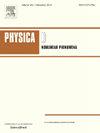离源加热湍流射流混合特性研究
IF 2.7
3区 数学
Q1 MATHEMATICS, APPLIED
引用次数: 0
摘要
具有体积非源加热的射流由于其与积云的相似性而被研究,在积云中,液滴凝结导致上升气流的非绝热加热。本研究通过大涡模拟研究了体积加热对射流动力学的影响,重点研究了不同理查德森(Ri)数下的加速度、速度、浓度宽度和质量通量行为。结果表明,加热对射流有加速作用,且Ri值越低,射流加速度越小,加速位置越远。速度和浓度宽度随加热而减小,而质量通量随Ri的增加而增加,这受计算长度尺度选择的影响。径向速度和夹带系数(α)随升温速率增大而增大,轴向和径向湍流强度增大,表明在研究参数范围内没有再层压化。温度场在最低Ri处呈现平坦的高斯分布,回归到高斯后加热相互作用区(HIZ)。相反,由于在较高的Ri值下减少了混合,在最低的Ri情况下获得了最大的轴向温度。没有观察到失禁的证据。本文章由计算机程序翻译,如有差异,请以英文原文为准。
Characterization of mixing in turbulent jet with off-source heating
Jets with volumetric off-source heating are studied due to their resemblance to Cumulus clouds, where droplet condensation leads to diabatic heating of updrafts. This study investigates the effects of volumetric heating on jet dynamics through large eddy simulations, focusing on acceleration, velocity, concentration widths, and mass flux behavior under varying Richardson (Ri) numbers. The results reveal that heating accelerates the jet, with the lowest Ri number exhibiting the smallest acceleration and the farthest location of acceleration. Whereas the velocity and concentration widths decrease with heating, the mass flux increases with Ri, influenced by the choice of length scale for calculations. The radial velocity and the entrainment coefficient () increase with the heating rate, and the axial and radial turbulent intensities rise, confirming no re-laminarization within the studied parameters. The temperature field shows a flattened Gaussian profile for the lowest Ri, reverting to the Gaussian post-heated interaction zone (HIZ). In contrast, the maximum axial temperature is achieved for the lowest Ri case due to reduced mixing at higher Ri values. No evidence of detrainment is observed.
求助全文
通过发布文献求助,成功后即可免费获取论文全文。
去求助
来源期刊

Physica D: Nonlinear Phenomena
物理-物理:数学物理
CiteScore
7.30
自引率
7.50%
发文量
213
审稿时长
65 days
期刊介绍:
Physica D (Nonlinear Phenomena) publishes research and review articles reporting on experimental and theoretical works, techniques and ideas that advance the understanding of nonlinear phenomena. Topics encompass wave motion in physical, chemical and biological systems; physical or biological phenomena governed by nonlinear field equations, including hydrodynamics and turbulence; pattern formation and cooperative phenomena; instability, bifurcations, chaos, and space-time disorder; integrable/Hamiltonian systems; asymptotic analysis and, more generally, mathematical methods for nonlinear systems.
 求助内容:
求助内容: 应助结果提醒方式:
应助结果提醒方式:


